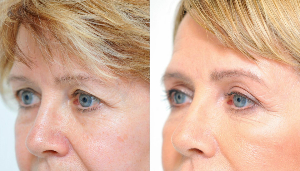
Aesthetic procedures and plastic surgeries that improve the appearance of the eyes are the most in demand. Last year alone, more than 200, 000 women and men underwent eyelid surgery (blepharoplasty), and aesthetic renewal procedures cannot even be counted.
What do you need to know for those who want to enhance this part of the face called the classic "mirror of the soul"?
Aesthetic problems in the eye area that need rejuvenation
- Heavy, tired appearance.
- Lowered eyelids.
- Bags or swelling under the eyes.
- Excessive, wrinkled skin.
Most of these problems can be successfully resolved by lifting the upper or lower eyelid. The goal of plastic surgery is to improve the three main components of eyelid tissue: skin, muscle and fat. The result is beautiful eyes and a youthful appearance.
Upper eyelid restoration
Most patients who visit beauty clinics complain of heavy, drooping upper eyelids, sometimes forming a kind of "hood. "This condition is called ptosis. Eyelid sagging can be hereditary or caused by injuries, nervous system diseases and even misuse of Botox.
Before the operation, the doctor finds out the causes of the eyelid slip, which allows you to prevent it most effectively. The condition of the eyelid muscles should be taken into account. If they are weak, cantopexy or cantoplasty is performed, which strengthens the muscle structures. This is usually done with blepharoplasty.
Excess skin and fat from the depths of the tissue are removed during the operation. The technique gives immediate results, improving the contour of the eyelids, making the look more open, and the face - relaxed and refreshed.
If the soft tissue of the forehead is loose and drooping, in addition to lifting the eyelids, eyebrow lifting and forehead correction are indicated.

How plastic surgery eliminates lower eyelid problems
The most common complaints in this area of the face are bags under the eyes. The skin of the lower eyelid is extremely sensitive and becomes thinner with age. Wrinkles appear under the eyes, similar to crumpled thin paper, through which fat stands out.
This position is corrected by lifting - lower blepharoplasty. During the operation, the excess skin is removed together with the raised fat. If necessary, the doctor tightens the stretched muscles.
In patients with a small amount of excess skin, it is compressed (compressed), which makes the contour of the lower eyelid smoother.
Significant age-related changes often require surgery on both eyelids to significantly restore the area.
Non-surgical eyelid restoration techniques
In addition to surgery, more and more non-surgical procedures are being performed to improve the appearance of eyelid skin:
- Microneedles- a procedure during which the skin is pierced with small needles. As a result, small holes remain on it, which the body tries to remove by producing collagen and elastin proteins.
- Chemical peelingwith various natural compounds that rejuvenate the skin and remove wrinkles.
- Laser procedures, stimulating metabolic processes and causing muscle contraction.
- Radio frequency and ultrasound proceduresthat tighten and smooth the skin.
Operational and non-operative eyelid correction methods should not be considered mutually exclusive. Both methods can be used together, organically complement each other and give excellent results.
Nazolacrimal groove correction
At the junction of the lower eyelid and cheek is a nasolacrimal groove that becomes more noticeable with age. The soft tissues of the face lose volume and the force of gravity causes them to stretch down. A dark, curved area forms under the eyelid, making the eyes look tired and outdated.
In the process of improving the aesthetics of this area, the tear duct is filled in several ways:
- With the help of fillers - fillers that supplement the volume of lost tissue.
- Adding fat cells moved from other parts of the body.
- The condition of this area is improved using non-surgical procedures - microdata, radio frequency, ultrasound and laser methods.
Platelet-derived plasma (PRP) injections are also used in patients. Plasma contains many growth factors that stimulate skin regeneration, which covers nasolacrimal sulcus.
A beautician will help you choose a combined method that consists of several procedures that complement each other.
Signs of eye area restoration
Upper and lower eyelid plastic surgery can provide immediate, long-lasting and noticeable results. But when managing them, an important nuance must be taken into account. Many areas of nerves and blood vessels pass through this area, and its tissues are very thin and delicate. Therefore, surgery can only be trusted by a physician with extensive experience in blepharoplasty.
Properly performed by experienced plastic surgeons and beauticians, the restoration procedure provides excellent results that satisfy patients.














































































